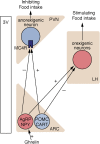Sirtuins in Neuroendocrine Regulation and Neurological Diseases
- PMID: 30416425
- PMCID: PMC6213750
- DOI: 10.3389/fnins.2018.00778
Sirtuins in Neuroendocrine Regulation and Neurological Diseases
Abstract
Silent information regulator 1 (SIRT1) is a mammalian homolog of the nicotinamide adenine dinucleotide (NAD)-dependent deacetylase sirtuin family. Sirtuin was originally studied as the lifespan-extending gene, silent information regulator 2 (SIRT2) in budding yeast. There are seven mammalian homologs of sirtuin (SIRT1-7), and SIRT1 is the closest homolog to SIRT2. SIRT1 modulates various key targets via deacetylation. In addition to histones, these targets include transcription factors, such as forkhead box O (FOXO), Ku70, p53, NF-κB, PPAR-gamma co-activator 1-alpha (PGC-1α), and peroxisome proliferator-activated receptor γ (PPARγ). SIRT1 has many biological functions, including aging, cell survival, differentiation, and metabolism. Genetic and physiological analyses in animal models have shown beneficial roles for SIRT1 in the brain during both development and adulthood. Evidence from in vivo and in vitro studies have revealed that SIRT1 regulates the cellular fate of neural progenitors, axon elongation, dendritic branching, synaptic plasticity, and endocrine function. In addition to its importance in physiological processes, SIRT1 has also been implicated in protection of neurons from degeneration in models of neurological diseases, such as traumatic brain injury and Alzheimer's disease. In this review, we focus on the role of SIRT1 in the neuroendocrine system and neurodegenerative diseases. We also discuss the potential therapeutic implications of targeting the sirtuin pathway.
Keywords: SIRT1; axon degeneration; central nervous system; neuronal development; sirtuin.
Figures


References
-
- Arai T., Hasegawa M., Akiyama H., Ikeda K., Nonaka T., Mori H., et al. (2006). TDP-43 is a component of ubiquitin-positive tau-negative inclusions in frontotemporal lobar degeneration and amyotrophic lateral sclerosis. Biochem. Biophys. Res. Commun. 351 602–611. 10.1016/j.bbrc.2006.10.093 - DOI - PubMed
Publication types
LinkOut - more resources
Full Text Sources
Research Materials
Miscellaneous

